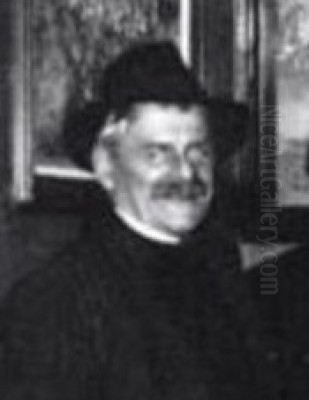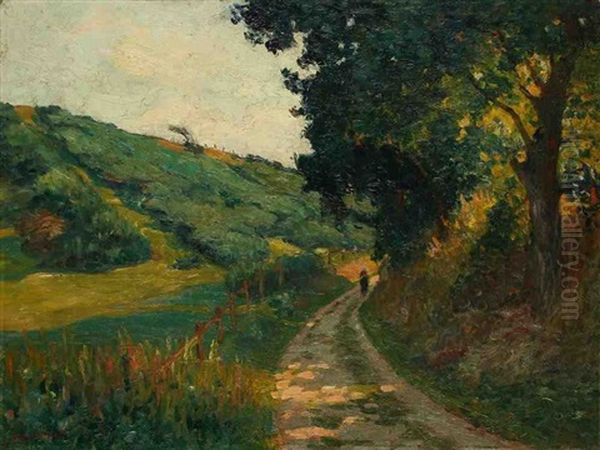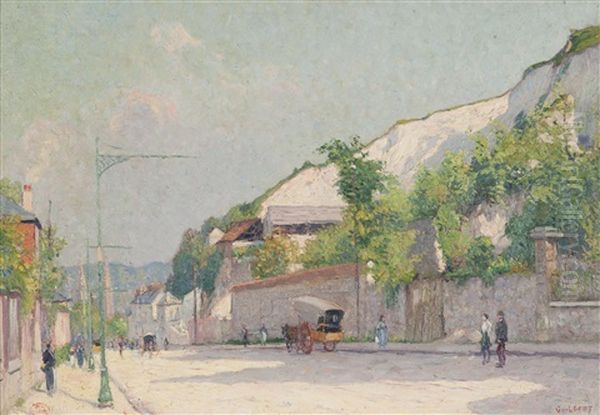
Narcisse Guilbert stands as a significant figure within the rich artistic tapestry of early 20th-century French painting. Born in 1878 and passing away in 1942, Guilbert dedicated his career to capturing the landscapes and ephemeral light of his native Normandy. As a prominent member of the L’École de Rouen (the Rouen School), his work embodies the continuation and evolution of Impressionist principles, interpreted through his unique sensitivity to color, light, and atmosphere. Though perhaps less internationally renowned than the first wave of Impressionists who occasionally painted in the region, Guilbert was a master in his own right, celebrated for his evocative depictions of the Seine valley, the Norman coast, and the intimate corners of the countryside he knew so well.
Humble Beginnings and a Fateful Move
Narcisse Guilbert's journey into the world of art began in modest circumstances. He was born on June 12, 1878, in Bouville, a small commune in the Seine-Maritime department of Normandy, France. His family background was described as very poor; his father worked as a carpenter. Tragedy struck early in Guilbert's life when his father died suddenly when Narcisse was just twelve years old. This event precipitated a significant change for the family.
Following her husband's death, Guilbert's mother made the pivotal decision to move with Narcisse and his sister from their home, possibly in Mont-Saint-Aignan near Rouen, into the city of Rouen itself. This relocation proved crucial for Guilbert's future artistic path. Rouen, with its vibrant artistic community and established institutions, offered opportunities that would have been unavailable in a smaller village. The city's picturesque medieval streets, its bustling port on the Seine, and the surrounding luminous landscapes would become central themes in his later work.
Early Work and Artistic Awakening in Rouen
Life in Rouen initially demanded practical work. The young Guilbert found employment, possibly as a delivery boy for a clothing store or working for an express company, to help support his family. However, his innate passion for art and evident talent could not be suppressed for long. The artistic atmosphere of Rouen, a city that had already captivated masters like Claude Monet and Camille Pissarro with its famous cathedral and river views, undoubtedly fueled his aspirations.

Recognizing his potential, Guilbert sought formal training. He enrolled at the L’École des Beaux-Arts de Rouen, the city's municipal art school. There, he studied under the guidance of Philippe Zacharie (1849-1915), a respected painter and teacher known for his landscapes and genre scenes. Zacharie's instruction would have provided Guilbert with a solid foundation in academic drawing and painting techniques, essential grounding for any aspiring artist of the time.
Further Studies and the Influence of Delattre
Guilbert's thirst for artistic knowledge led him to seek further instruction beyond the municipal school. He joined the Académie libre founded by Joseph Delattre (1858-1912). Delattre was himself a key figure in the Rouen art scene, a landscape painter deeply influenced by Impressionism, particularly the works of Monet. His 'free academy,' likely less formal and perhaps more focused on modern approaches than the École des Beaux-Arts, provided a stimulating environment for young artists.
Studying with Delattre was a profound experience for Guilbert. Delattre championed painting en plein air (outdoors) and encouraged his students to capture the immediate sensations of light and atmosphere. This approach resonated deeply with Guilbert, shaping his artistic direction towards landscape painting and reinforcing the Impressionist sensibilities he would cultivate throughout his career. The mentorship of both Zacharie and Delattre provided Guilbert with a blend of traditional skill and modern vision.
The École de Rouen: A Community of Light
Narcisse Guilbert became an integral member of what is known as L’École de Rouen. This was not a formal institution with a building and curriculum, but rather a term used to describe successive generations of artists based in or strongly associated with Rouen from roughly the 1870s through the mid-20th century. These artists were united by their focus on the local landscape – the Seine river, the port, the surrounding countryside, the city's architecture – and by their shared interest in capturing the effects of light and atmosphere, largely inspired by Impressionism and its subsequent developments.
The first generation associated with the Rouen 'school' included artists like Joseph Delattre and Charles Angrand (who later moved towards Neo-Impressionism), alongside the foundational influence of visiting giants like Monet and Pissarro. Albert Lebourg (1849-1928), another major figure, bridged the earlier and later phases and was noted in sources as having led a group of Rouen painters that included Guilbert, suggesting a direct influence or mentorship role. Lebourg himself was renowned for his delicate, light-filled views of the Seine.

Guilbert belonged more to the second wave or later flourishing of the École de Rouen, active primarily in the early 20th century. He was part of a vibrant community of painters who often worked and exhibited together. Sources confirm his close association and regular painting excursions with fellow Rouen artists such as Marcel Couchaux (1877-1939), Pierre Le Tridivic (1890-?), Narcisse Hénocque (1879-1952), and Maurice Louvrier (1878-1954). This camaraderie and shared artistic purpose were characteristic of the school.
Other notable artists associated with the broader École de Rouen during its active periods include Léon-Jules Lemaître (1850-1905), Charles Frechon (1856-1929), and later figures like Robert Antoine Pinchon (1886-1943) and Pierre Dumont (1884-1936), who brought Fauvist and Cubist influences into the Rouen scene while still engaging with the local landscape tradition. Albert Malet (1912-1986), mentioned as a collaborator in one source, represents a later continuation of this regional artistic identity. Guilbert's place within this lineage is secure as one of its dedicated and talented landscape interpreters.
Guilbert's Artistic Style: Sensitivity to Light and Color
Narcisse Guilbert's art is characterized by a profound sensitivity to the nuances of light and color, applied primarily to landscape and, to a lesser extent, still life subjects. His style is firmly rooted in the Impressionist tradition passed down through figures like Delattre and Lebourg, focusing on capturing the fleeting moments of changing daylight and weather conditions. He was particularly adept at rendering the soft, often hazy light of the Seine Valley and the brighter, clearer atmosphere of the Normandy coast.
His technique involved typically Impressionist and Post-Impressionist elements: visible, often delicate brushwork, a palette that emphasized chromatic harmony and the optical effects of light, and a commitment to painting outdoors to capture direct observations. However, Guilbert developed his own distinct voice. His works often possess a gentle lyricism and a quiet intimacy. While capable of rendering bright sunlight, he also excelled at depicting more subdued effects – misty mornings, overcast skies, or the warm glow of a setting sun, as suggested by the title Sentier au soleil couchant (Sunset Path).
Sources praise his "beauty of color" and "great sensitivity of detail," indicating that while his work captured broad atmospheric effects, he did not sacrifice structure or specificity entirely. This balance suggests a Post-Impressionist sensibility, where the lessons of Impressionism are absorbed but perhaps combined with a greater attention to composition and form than seen in the most radical works of Monet, for example. His primary medium was oil paint, applied with a touch that could be both fluid and precise.
Favorite Themes: Normandy's Landscapes and Waterscapes
Guilbert's oeuvre is dominated by depictions of his beloved Normandy. He frequently painted along the banks of the Seine River near Rouen, capturing the interplay of water, sky, and the surrounding terrain. Works like Péniche en bord de Seine (Barge on the Banks of the Seine) and Bateaux la Seine aux environs de Rouen (Boats on the Seine near Rouen) exemplify this focus. These scenes often feature the characteristic river barges, riverside paths, and gentle hills of the region, bathed in carefully observed light.
He was also drawn to the coastal landscapes of Normandy, known for their dramatic cliffs, beaches, and changeable weather. The source material mentions him painting frequently on the Normandy coast, seeking out its unique maritime light and scenery. Additionally, he undertook painting campaigns in Brittany, another region famed for its rugged coastline and distinct artistic traditions, attracting artists like Paul Gauguin and Émile Bernard decades earlier.
Beyond pure landscapes, Guilbert also painted urban scenes, such as the work titled Rue animée (Lively Street). This suggests an interest in capturing the life and atmosphere of towns, likely Rouen itself, complementing his rural and riverside subjects. The mention of still lifes indicates a versatility beyond landscape, though landscape remained his primary focus and the area where he gained his reputation as one of Rouen's most distinguished painters. The work LE MANOIR (The Manor), referenced with dates of 1925 and 1942 (possibly indicating different works or a recurring subject), points to an interest in architectural elements within the landscape as well.
Career, Exhibitions, and Recognition
Narcisse Guilbert actively participated in the artistic life of his time, exhibiting his work regularly. He showed his paintings at the Salon de Rouen, the main regional venue for artists associated with the city. His participation in these local salons was crucial for establishing his reputation within the Norman art community.
Furthermore, Guilbert also exhibited at the prestigious Paris Salons. Showing work in Paris was essential for any French artist seeking wider recognition beyond their home region. His presence in these major exhibitions indicates a level of ambition and achievement that placed him within the broader context of French art during the early 20th century. His consistent exhibition activity underscores his professional commitment to his art.
His reputation was primarily as a highly skilled and sensitive landscape painter. The description of him as "one of the most outstanding landscape painters of the Rouen region" highlights the esteem in which he was held locally. His ability to capture the specific atmospheric conditions and scenic beauty of Normandy resonated with regional audiences and fellow artists.
An interesting, though less common, aspect of his influence is mentioned in the source material: Guilbert's work apparently inspired several contemporary poets, including Tournaire Philippe, Pierre Laurent, Roger Vaccaro, and Costa de Beauregard. This suggests that the evocative, atmospheric quality of his paintings had a reach beyond the visual arts, stimulating literary responses and highlighting the emotional resonance of his landscapes.
Representative Works
Several specific works are mentioned as representative of Narcisse Guilbert's output, giving us a clearer picture of his subjects and style:
Sentier au soleil couchant (Sunset Path): This title strongly suggests a landscape focused on the effects of light at a specific time of day, a classic Impressionist and Post-Impressionist theme. One can imagine a scene imbued with warm, golden, or reddish hues, capturing the fleeting beauty of twilight in the Norman countryside.
Rue animée (Lively Street): This work indicates his engagement with urban scenes. It likely depicted a bustling street, perhaps in Rouen, focusing on the movement of people and vehicles, and the play of light and shadow on buildings. The dimensions given (23 x 31.78 inches) suggest a moderately sized canvas suitable for capturing such a scene with some detail.
LE MANOIR (The Manor): Mentioned with potential dates of 1925 and 1942 and dimensions of 50 x 61 cm (approx. 19.7 x 24 inches). This title points to an interest in depicting significant architectural structures within the landscape. A manor house could serve as a focal point, allowing Guilbert to explore the relationship between man-made forms and the natural environment, again likely with a focus on light effects.
Péniche en bord de Seine (Barge on the Banks of the Seine): This title clearly places the work within his favored theme of the Seine River landscape. Barges were a common sight on the river and a frequent motif for artists of the École de Rouen, symbolizing the commercial lifeblood of the region and offering interesting shapes and reflections on the water.
Bateaux la Seine aux environs de Rouen (Boats on the Seine near Rouen): Similar to the previous title, this work (oil on canvas, 36 x 55 cm, approx. 14.2 x 21.7 inches, signed lower right) confirms his dedication to the river Seine as a subject. It likely featured various types of boats moored or navigating the river near Rouen, offering opportunities to study reflections, water currents, and the surrounding riverside scenery.
These titles collectively paint a picture of an artist deeply engaged with the visual motifs of his region – pathways, streets, buildings, and especially the ever-present Seine River – always interpreted through a lens sensitive to light, color, and atmosphere.
Later Life and Lasting Legacy
Narcisse Guilbert continued to paint throughout his life, remaining dedicated to his craft and his Norman subjects. His association with the École de Rouen placed him firmly within a significant regional art movement that celebrated the local landscape through the evolving language of Impressionism and Post-Impressionism. He witnessed considerable changes in the art world, from the Fauvist explosion shortly after the turn of the century to the rise of Cubism and abstraction, yet he appears to have remained largely faithful to his own representational, light-focused style.
He passed away in 1942 at the age of 64. His death occurred during the difficult years of World War II and the German occupation of France, a period that cast a shadow over cultural life.
Narcisse Guilbert's legacy lies in his contribution to the ongoing story of French landscape painting and, more specifically, to the identity of the École de Rouen. He stands as a testament to the enduring appeal of the Norman landscape and the Impressionist quest to capture fugitive effects of light and atmosphere. While perhaps overshadowed on the international stage by artists with more radical styles or connections to the Parisian avant-garde, Guilbert's work possesses a quiet authenticity and a mastery of his chosen genre. His paintings offer a sincere and beautifully rendered vision of Normandy, preserving the region's unique light and landscapes for posterity. He remains a respected figure within the history of Norman art, admired for his skill, his sensitivity, and his deep connection to his native soil. His work continues to be appreciated by collectors and enthusiasts of French landscape painting from the early 20th century.